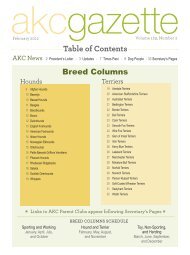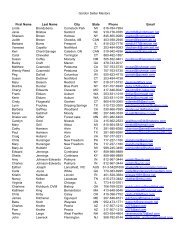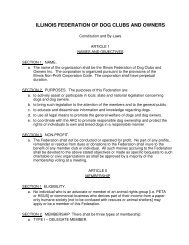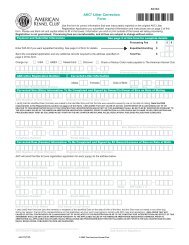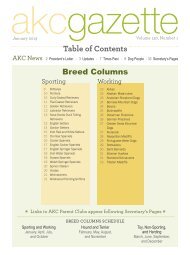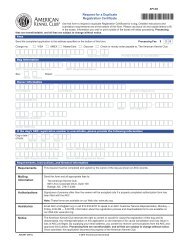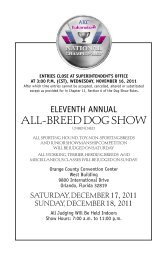Download - Parent Directory - American Kennel Club
Download - Parent Directory - American Kennel Club
Download - Parent Directory - American Kennel Club
- No tags were found...
Create successful ePaper yourself
Turn your PDF publications into a flip-book with our unique Google optimized e-Paper software.
GZ BREED COLUMNStoysing relationship and understanding. Towatch them fly through their paces is awonder!Miniature Pinschers are versatile dogsand can adapt to just about any situationyou put them in. Those of us whoare breeders and trainers know it isimportant to socialize this smart, tough,entertaining breed early and alwaystreat them with respect. The MiniaturePinscher is a talented and intelligentpartner in any endeavor!Breed news. A young conformationcontender has surpassed breed winrecords that have stood for the last 35years. GCh. Marlex Classic Red Glare(Classie) has just accumulated 45 AKCall-breed Bests in Show, to tie therecord held by Ch. Jay-Mac’sImpossible Dream (Impy).Congratulations to her owners LeahMonte and Armando Angelbello.Classie is handled by Armando and wasbred by Carole Ann Mohr-Rio. —KimByrd, kisakennel.com; MiniaturePinscher <strong>Club</strong> of America website:Minpin.orgPapillonsConditioning a Papillon forConformation PART ONEIt is certainly gratifying to hearpeople make positive remarks aboutyour Papillon. It is even morerewarding, however, when commentssuch as “He’s in beautiful condition”come from judges. It indicates thatyou’ve achieved recognition validatingall your hard work and dedication inpreparing your dog for the show ring.Conditioning consists of many components;nutrition, exercise, socialization,handling techniques, and grooming.Following genetics, conditioning isthe next-strongest influence in successfullypresenting a Papillon in conformation.Conditioning starts from the inside,with proper nutrition. For health andsafety issues, a Papillon should eat awell-balanced diet of top-quality commercialfood that does not contain premixed,synthetic vitamins from foreignsources. There is an art to finding justthe right, healthy diet that is specificallydesigned for our high-energy toys. Itshould consist of nutritionally balancedwhole foods made from wholesomeingredients, yet it must be palatable forpicky eaters, easily digestible so as toproduce healthy stools, and above all,safe for consumption.Exercise, such as walking yourPapillon, is one element to good conditioningthat should not be overlooked.A brisk walk for one hour a day at leastfive times a week can accomplish a lotwith a small dog. It will help tostrengthen bones and ligaments, buildmuscle tone, improve gait, and subsequentlyimprove his chance of successin the show ring. If targeted to specificareas, exercise can even help improveweak rears and fronts. Walking up stairsand hills will help strengthen rear muscles,while going down stairs and hillswill help to strengthen weak fronts.Walking together is a win-win situation,where you will bond with yourdog while both of you benefit from theexercise.Socialization is vital in making a successfulshow career and in enhancingthe quality of life for both you andyour Papillon. It begins at birth, withthe pup’s associations with his environment.If a Papillon is well socializedwith other dogs and people and wasable to handle adventurous places at ayoung age, he will be better preparedfor new situations when he competesin the show ring. In my experience,exposing a puppy to loud noises, TVand radio, and people giving him treatswill help condition him and alleviatesubsequent fears of the unknown.The benefits from attending handlingclasses are twofold. They are an excellentway for your Papillon to socializeand practice in conformation showing.It will help him become more accustomedto strangers, large dogs, and loudnoises while learning how to gait at theright pace and stack for examination.Meanwhile, you will be getting tipsfrom the instructor on how to presentyour Papillon to his best advantage. Notall Papillons are perfect, and you mayneed instruction on handling techniquesto accentuate your dog’s goodattributes and camouflage his faults.Practicing the correct gait for his individualneeds helps you develop goodtiming to be in sync with him. Somewillful dogs need more control thanothers and will move better when youwalk slightly ahead of them, not givingthem too much lead, while others withstrong fronts and excellent conformationshould go out at the end of a leadto show their beautiful outline and sidegait. —Roseann Fucillo,cilloette@yahoo.com; Papillon <strong>Club</strong> ofAmerica website: papillonclub.orgPekingeseOur guest columnist is PamelaWinters, of Draco Pekingese inVista, California(pamela.winters1@cox.net).The Study of the PekingesePART ONEOur Pacific Coast Pekingese <strong>Club</strong>members have been studying thebreed’s standard bit by bit, and we havecome to wrapping up some of the finalpoints (coat, color, gait, and temperament).I am not going into detail onthese qualities, as they can be writtenabout but never understood until actuallyseen. Rather I will make a fewobservations, with the idea that we caneventually all get together off and onand ask questions and continue learningabout the breed.And let me remind you: Don’t justask one or two people. Each person hasan individual preference of what theylike and don’t like in the breed, and it isnot only not necessarily right or wrong,but may simply be one of the manycorrect “looks.” You need to developthe “type” you prefer, and only immersionin the breed will help you do this.Go to shows. Visit breeders. Readeverything you can, and use old issuesof The Orient Express to study picturesof the Pekes advertised, so you can trainyour eye to see what is considered acorrect look. And start picking outqualities you like or don’t like, and dis-A K C G A Z E T T E • 15 • S E P T E M B E R 2 0 1 2




